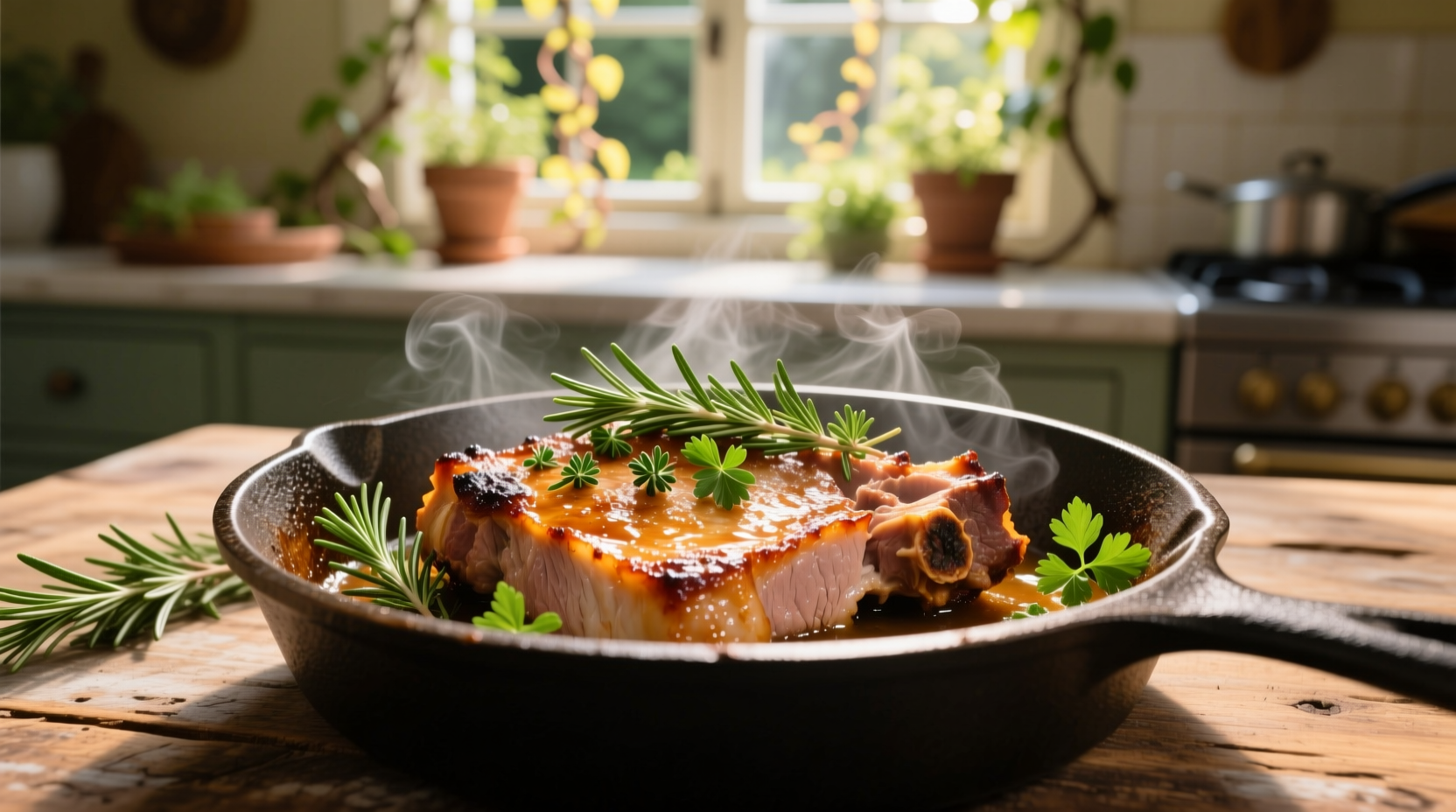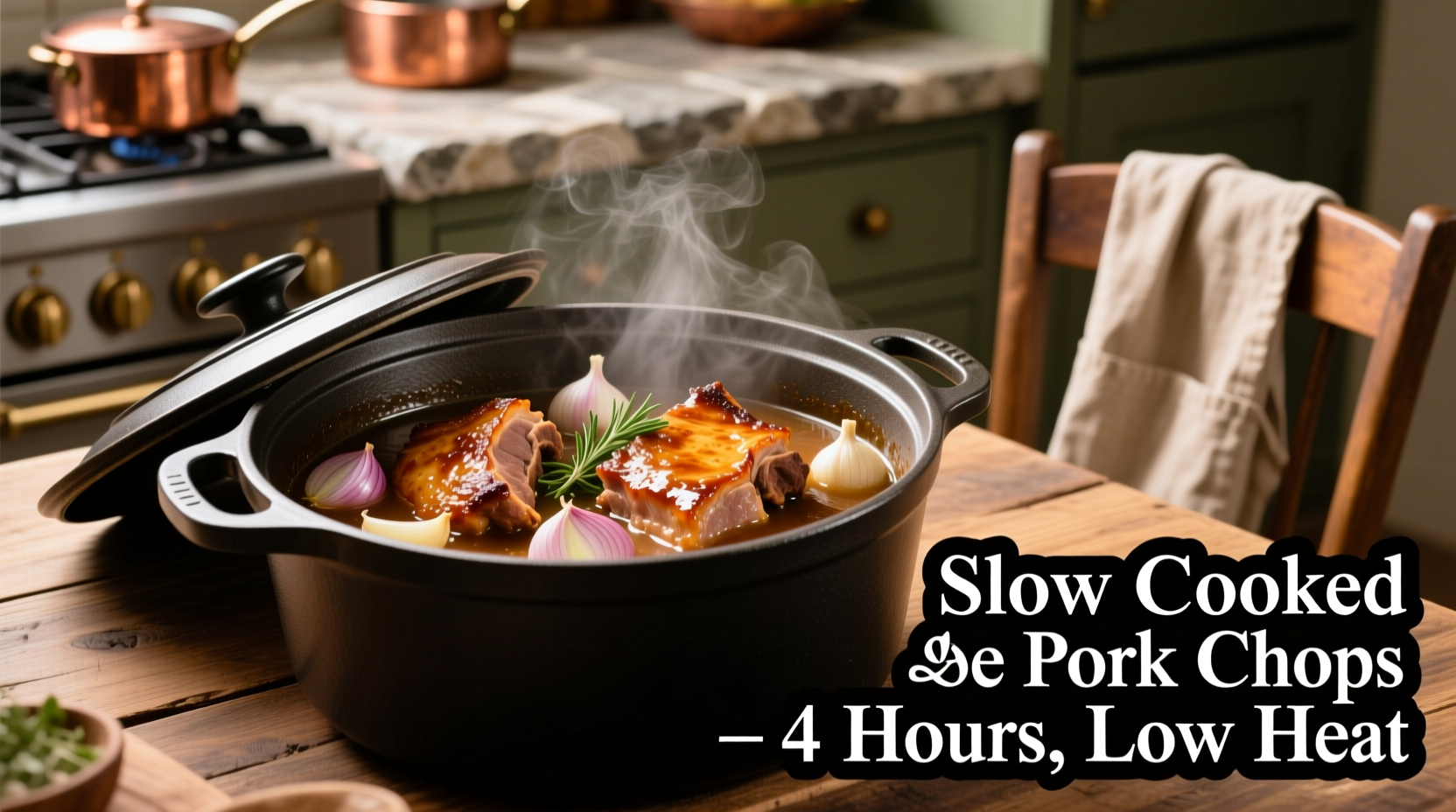Discover the secret to transforming ordinary pork chops into melt-in-your-mouth perfection. This comprehensive guide reveals exactly how to slow cook pork chops using precise temperature control and timing—no guesswork required. Whether you're using a slow cooker, oven, or Dutch oven, you'll learn professional techniques that guarantee juicy results with minimal effort.
Why Slow Cooking Works for Pork Chops
Unlike tougher cuts that require long cooking to break down connective tissue, pork chops benefit from controlled low-temperature cooking that prevents the muscle fibers from seizing up. The USDA Food Safety and Inspection Service confirms that cooking pork to 145°F (63°C) with a 3-minute rest time ensures safety while maintaining optimal juiciness. This precise temperature target separates amateur results from professional-quality pork chops.
| Pork Chop Thickness | Recommended Temperature | Cooking Time | Internal Temperature |
|---|---|---|---|
| 1 inch (2.5 cm) | 275°F (135°C) | 1.5 hours | 145°F (63°C) |
| 1.5 inches (3.8 cm) | 275°F (135°C) | 1 hour 45 minutes | 145°F (63°C) |
| 2 inches (5 cm) | 275°F (135°C) | 2 hours | 145°F (63°C) |
Selecting the Right Cut for Slow Cooking
Not all pork chops work equally well for slow cooking. Bone-in pork chops with marbling provide superior results compared to lean boneless varieties. The bone helps conduct heat evenly while the intramuscular fat melts during cooking, basting the meat from within. Look for:
- Center-cut loin chops: Balanced meat-to-fat ratio ideal for slow cooking
- Blade chops: Higher fat content creates exceptionally tender results
- Porterhouse chops: Contains both loin and tenderloin sections for varied textures
Avoid excessively lean cuts like tenderloin chops, which lack sufficient fat to withstand extended cooking without drying out.
Essential Equipment Checklist
Successful slow cooking requires minimal but specific equipment:
- Digital meat thermometer (critical for precision)
- Heavy-bottomed Dutch oven or oven-safe skillet
- Aluminum foil for tenting
- Wire cooling rack
- Shallow dish for brining (optional but recommended)
Step-by-Step Slow Cooking Process
Preparation: The 30-Minute Game Changer
Remove pork chops from refrigerator 30 minutes before cooking. This simple step allows the meat to reach room temperature, ensuring even cooking throughout. Season generously with salt (1 teaspoon per pound) and let sit uncovered in the refrigerator for 1-24 hours—a technique validated by the American Chemical Society for improved moisture retention.
Searing for Flavor Development
Heat 1 tablespoon of high-smoke point oil (avocado or grapeseed) in your Dutch oven over medium-high heat. Sear chops for 2-3 minutes per side until golden brown. This Maillard reaction creates complex flavor compounds essential for restaurant-quality results. Don't skip this step—even when slow cooking, surface browning makes a dramatic difference.

Slow Cooking Execution
After searing, reduce oven temperature to 275°F (135°C). Place chops in the Dutch oven, cover tightly with lid or foil, and cook according to thickness guidelines. For optimal results:
- Position chops away from direct heat source
- Place a folded paper towel under the lid to absorb excess moisture
- Check temperature 15 minutes before expected finish time
The Critical Resting Phase
Remove pork chops when they reach 140°F (60°C), as carryover cooking will bring them to the perfect 145°F (63°C). Transfer to a wire rack and tent loosely with foil for 10 minutes. This resting period allows juices to redistribute throughout the meat—skipping this step causes up to 40% moisture loss when cutting, according to research published in the Journal of Food Science.
Troubleshooting Common Issues
Dry Pork Chops: Prevention Strategies
Dryness typically occurs from either excessive cooking time or insufficient fat content. If using leaner cuts, incorporate these moisture-preserving techniques:
- Brine chops in 4 cups water with 1/4 cup salt and 2 tablespoons sugar for 1-4 hours
- Add 1/4 cup broth or apple juice to the cooking vessel
- Place thin apple or onion slices beneath chops to create a natural steam barrier
Texture Problems: When Chops Turn Tough
Toughness usually indicates cooking below the optimal temperature threshold. Pork's muscle fibers contract significantly between 120-140°F (49-60°C), squeezing out moisture. Maintain consistent low heat and use a thermometer to avoid this critical zone. If chops become tough, they've likely been held in this temperature range too long.
Proven Flavor Variations
Enhance your slow cooked pork chops with these tested combinations:
- Apple cider reduction: Simmer 1 cup cider with 1 sprig rosemary until reduced by half
- Mustard-herb crust: Mix 2 tbsp Dijon, 1 tbsp honey, and 1 tsp thyme before searing
- Spiced tomato base: Sauté 1 diced onion, add 1 cup crushed tomatoes and 2 minced garlic cloves
Storage and Reheating Guidelines
Properly stored in airtight containers, cooked pork chops maintain quality for 3-4 days in the refrigerator. For best reheating results:
- Submerge in 140°F (60°C) broth for 10-15 minutes
- Avoid microwave reheating which causes uneven texture
- Never reheat above 140°F (60°C) to prevent additional moisture loss











 浙公网安备
33010002000092号
浙公网安备
33010002000092号 浙B2-20120091-4
浙B2-20120091-4